Overview
This article delves into best practices for effectively handling null values in DAX. Understanding and managing ‘BLANK’ entries is crucial for ensuring accurate data analysis. Essential DAX functions such as ISBLANK and COALESCE are detailed to provide clarity on their application. Additionally, strategic approaches like proactive checks and effective visualization methods are discussed, collectively enhancing data quality and informing decision-making processes.
Introduction
In the realm of data analysis, managing null values is a critical yet often overlooked aspect that can significantly influence the integrity and accuracy of insights derived from datasets. Represented as ‘BLANK’ in DAX, these null values demand careful handling to avoid pitfalls that distort calculations and mislead decision-makers. As organizations increasingly rely on data-driven strategies, understanding the nuances of null values becomes essential for data professionals aiming to enhance their analytical capabilities.
This article delves into the complexities surrounding null values in DAX, exploring best practices, key functions, and advanced techniques that empower analysts to effectively manage these challenges. By mastering these concepts, professionals can ensure their analyses remain robust and reliable. Ultimately, this drives informed decision-making and fosters growth in today’s competitive landscape.
Understanding Null Values in DAX: A Primer
In DAX, null entries are represented as ‘BLANK,’ a crucial distinction that significantly influences analysis. DAX treats BLANK distinctly compared to other data types, making it imperative for data professionals to grasp how these elements are interpreted. Mismanagement of BLANK principles can lead to unexpected outcomes in calculations, underscoring the importance of appropriate handling techniques.
Familiarity with the concept of BLANK is essential to avoid common pitfalls in analyses. Moreover, understanding the difference between an empty entry and a zero is vital, as they convey different meanings within information contexts. A null signifies the absence of information, while zero represents a numeric value that can affect calculations and aggregations in unique ways. Recognizing these distinctions ensures that evaluations are accurate and reliable, ultimately enhancing the quality of insights derived from information.
In today’s information-rich environment, leveraging Business Intelligence tools can help organizations tackle challenges related to poor master information quality and barriers to AI adoption. By implementing RPA solutions, companies can automate repetitive tasks, thereby increasing efficiency and allowing professionals to focus on extracting actionable insights from their evaluations. This synergy between BI and RPA not only drives operational efficiency but also supports informed decision-making that promotes growth and innovation.
According to a case study titled ‘Best Practices for Handling Missing Information,’ it is crucial to identify the type of absence and select appropriate handling methods to minimize information loss. This understanding is vital, as mishandling absent information can significantly reduce the effectiveness of evaluations, particularly in trials. Recent discussions emphasize that maximizing information collection during study design is the best approach to address absent values, as single imputation and Last Observation Carried Forward (LOCF) methods may introduce bias.
As Nasima Tamboli, a Freelance Software Engineer and Data Science Enthusiast, notes, “Consider the potential biases and implications of the selected method on your evaluation.” This perspective highlights the importance of understanding principles related to null in DAX and the broader implications of absent information in data evaluation, especially when supported by robust BI and RPA frameworks.
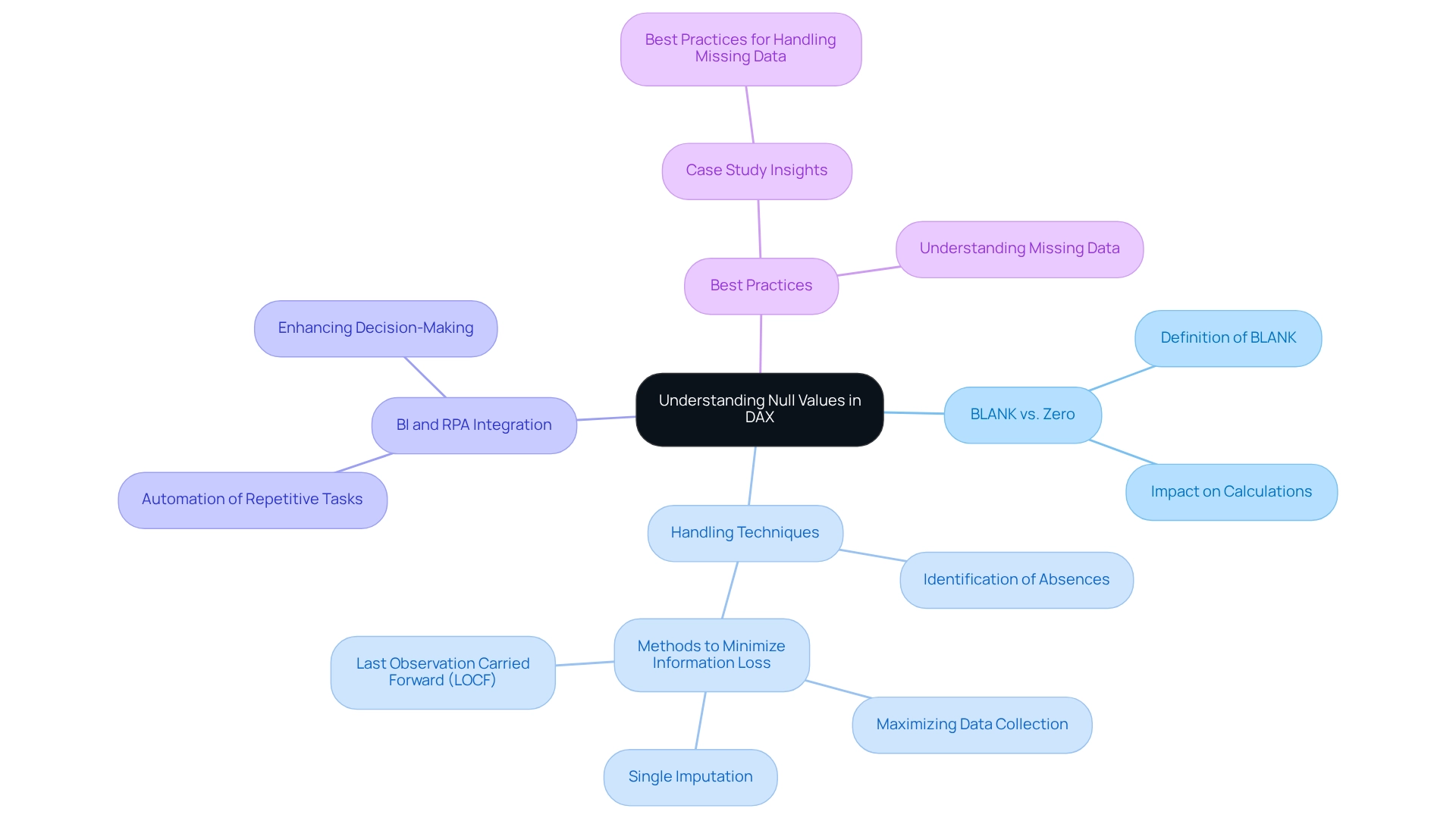
Common Challenges with Null Values in Data Analysis
Data experts frequently encounter significant challenges when managing null values in DAX entries during their analyses. A common issue is the misinterpretation of BLANK figures during calculations, which can lead to distorted results. For instance, merging datasets that contain BLANK entries can produce misleading averages or totals, ultimately skewing insights.
Moreover, absent entries complicate relationships among data, particularly in models where certain fields are expected to contain information. This complexity can result in incomplete visual representations and erroneous reports, undermining the reliability of the analysis.
The implications of missing entries extend beyond mere misinterpretation; they can also adversely affect the precision of data. Statistics indicate that a considerable percentage of information professionals report difficulties associated with null values in DAX, with many noting that these challenges diminish the quality and reliability of data. This concern is especially critical in an information-rich environment where organizations rely on Business Intelligence (BI) to transform raw data into actionable insights that drive growth and innovation.
Employing robust statistical methods can enhance the reliability of results, making it imperative for professionals to address these challenges effectively. Furthermore, the presence of missing entries can impede the efficiency of DAX queries, necessitating additional processing to manage these situations.
As Diego Vallarino, PhD, aptly notes, ‘Comprehending entropy is crucial for revealing the potential of information assessment,’ underscoring the importance of grasping the complexities introduced by absent elements. Organizations that have established clear information governance policies have successfully navigated these challenges. By defining how data should be managed and ensuring adherence to standards, they have improved their handling of null values in DAX, leading to more accurate and reliable analyses.
This enhancement is essential for leveraging RPA solutions, such as EMMA RPA and Power Automate, which aim to automate repetitive tasks and boost operational efficiency.
For example, implementing these guidelines has empowered organizations to directly confront prevalent quality issues, such as incomplete and inconsistent data, which obstruct successful AI adoption. Understanding these challenges is crucial for professionals striving to implement effective solutions and elevate the overall quality of their data-driven insights. Additionally, clarity in reporting how absent data was managed is vital for building trust in findings and comprehending the methodologies behind results.
Creatum GmbH recognizes that difficulties in extracting valuable insights can position companies at a competitive disadvantage, making it essential to address these quality challenges.
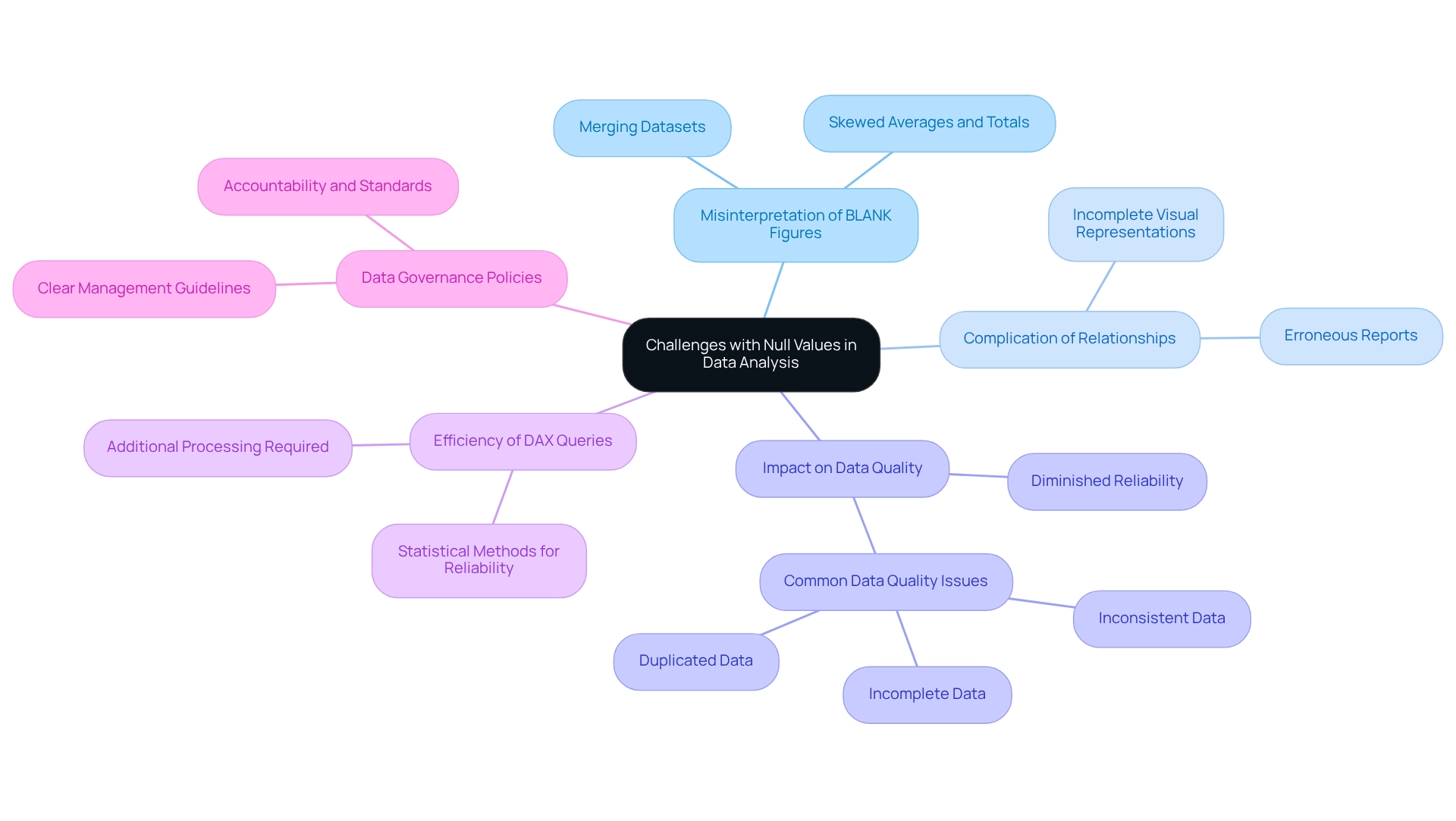
Key DAX Functions for Identifying Null Values
DAX functions play a crucial role in efficiently identifying and addressing missing entries, or null values, within datasets—an essential aspect of enhancing data quality, particularly in Business Intelligence and RPA implementation at Creatum GmbH. The ISBLANK function serves as a fundamental tool, enabling users to determine if an entry is BLANK, returning TRUE or FALSE as needed. This function proves especially useful in conditional statements, facilitating the removal or substitution of empty entries in calculations.
For example, a common application involves using IF in conjunction with ISBLANK to formulate more intricate logic for managing empty values. A typical structure is IF(ISBLANK(input), alternative_value, input), which provides a default option when an empty entry is encountered, ensuring that computations remain robust and meaningful.
In addition to ISBLANK, the COALESCE function is invaluable for retrieving the first non-BLANK value from a list of arguments. This function simplifies the management of multiple potential empty values in calculations, streamlining the process and enhancing information quality. The effectiveness of these functions is underscored by their extensive usage; statistics reveal that 2,287 users are currently online in the Fabric community, actively employing these DAX functions to improve their information handling practices.
Moreover, recent discussions within the community underscore the importance of grasping the nuances of these functions, particularly the recent updates to the ISBLANK function that augment its capability in identifying null values in DAX. As Angela, a frequent visitor, noted, “Thank you for continuing to help with this. I tried that edit but same result, it’s returning all as ‘null’. Does the order of expressions matter?” This inquiry reflects the real-world challenges users encounter when navigating DAX functions. Case studies illustrate how organizations, including Creatum GmbH, have successfully leveraged the ISBLANK function to enhance information quality, ultimately driving growth and innovation.
By mastering these DAX functions, analytics professionals can significantly elevate their analytical capabilities and ensure more precise decision-making, directly contributing to their organization’s success. Furthermore, addressing the challenges associated with poor master data quality is vital for unlocking data-driven insights that enhance operational efficiency.

Best Practices for Managing Null Values in DAX
Effectively managing empty entries, or null values in DAX, requires a strategic approach grounded in best practices. Begin by leveraging the ISBLANK function to check for empty entries before executing calculations. This proactive measure not only prevents errors but also guarantees the accuracy of your analysis—an essential aspect in a data-rich environment where extracting meaningful insights can be particularly challenging.
Moreover, consider substituting empty values with meaningful defaults using the IF function or COALESCE. Such practices enhance the interpretability of your reports, rendering the information more accessible to stakeholders and promoting informed decision-making that drives growth and innovation.
Maintaining uniform data types across your model is crucial for minimizing empty values. For example, ensure that numeric fields do not contain text entries that could inadvertently result in BLANK outputs. Additionally, documenting your strategies for managing null values within your DAX code significantly enhances readability and maintainability.
This transparency facilitates comprehension of your logic by others, fostering collaboration and knowledge sharing—key elements for overcoming barriers to AI adoption in organizations.
Integrating these best practices not only streamlines your DAX procedures but also aligns with the broader goal of enhancing information quality and fostering innovation within your organization. Tailored solutions, such as EMMA RPA and Power Automate from Creatum GmbH, play a pivotal role in this context, as they enhance information quality and streamline AI implementation, ultimately nurturing growth and innovation.
As Yogana S. aptly states, “Viewing information validation as the sentinel of analytical integrity, it’s akin to fortifying the foundations of a building.” This perspective underscores the importance of efficiently managing empty entries. Furthermore, the case study titled ‘Enhancing Data Validation Abilities’ illustrates the significance of data validation methods for data analysts, demonstrating how addressing missing entries contributes to generating reliable analytical outcomes.
It is also important to note that restrictions exist on DAX expressions permitted in measures and calculated columns, making the handling of null values essential in DAX calculations. By adhering to these best practices, you can ensure the reliability of your analyses and cultivate a culture of continuous improvement, ultimately positioning your organization for success in a competitive landscape. To discover how Creatum GmbH can assist you in enhancing your Business Intelligence and RPA capabilities, schedule a free consultation today.
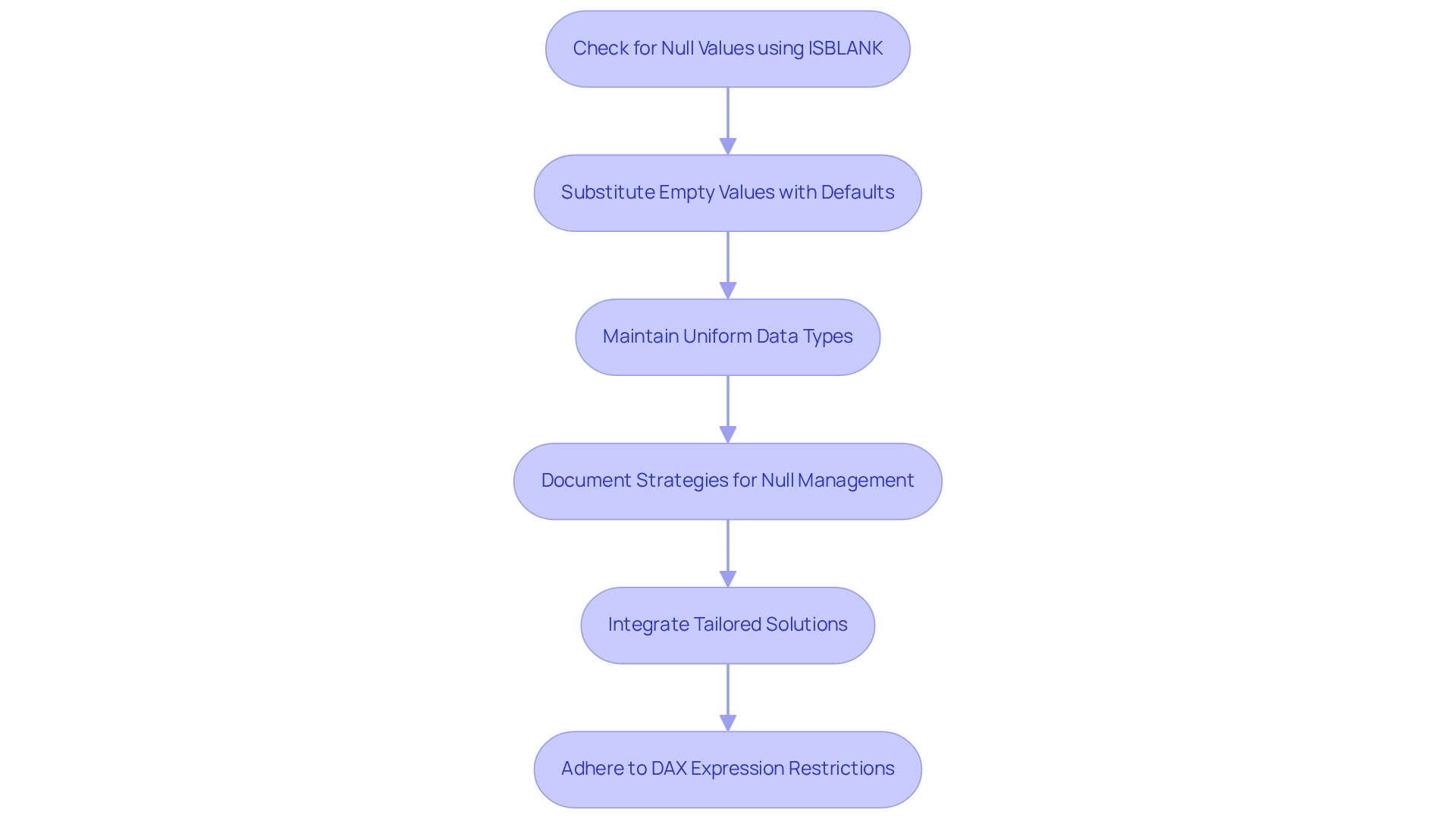
Visualizing Null Values: Techniques for Clear Reporting
Effectively representing absent data, such as null in DAX, is essential for clear and informative reporting, particularly when utilizing Business Intelligence to enhance decision-making. One effective method involves using conditional formatting in Power BI, which highlights cells containing empty entries, making them easily identifiable. As noted by Marlous Hall from the Leeds Institute of Cardiovascular & Metabolic Medicine, ‘Conditional formatting is vital for highlighting important metrics, such as missing entries, which can greatly influence decision-making.’
This aligns with our Power BI offerings at Creatum GmbH, ensuring effective reporting and information consistency. Our 3-Day Power BI Sprint facilitates swift report generation, while the General Management App provides thorough management solutions.
Moreover, adding labels or annotations in charts offers context regarding the presence of absent entries, assisting stakeholders in grasping their significance. Developing specialized visualizations that specifically address the issue of null in DAX values is another crucial method. For instance, bar charts that contrast the number of empty values against non-empty ones can vividly demonstrate the impact of missing information on overall trends.
This approach emphasizes the magnitude of the problem and enables a deeper examination of data reliability, particularly concerning null in DAX, which is vital for informed decision-making. In a dataset containing 86 fields, addressing missing entries becomes even more critical, as unforeseen gaps can lead to significant insights being overlooked. Recent discoveries revealed a total of 158 intersections indicating null in DAX codes in diagnostic fields, underscoring the importance of accurately reporting empty entries.
Furthermore, incorporating legends or descriptive notes in visualizations to explain how missing data is managed is essential. This level of transparency enhances the audience’s understanding of the information and fosters trust in the insights presented. By applying these methods, information specialists can significantly improve the transparency and impact of their reporting on missing entries, ultimately enabling companies to derive meaningful insights from their data and foster growth.
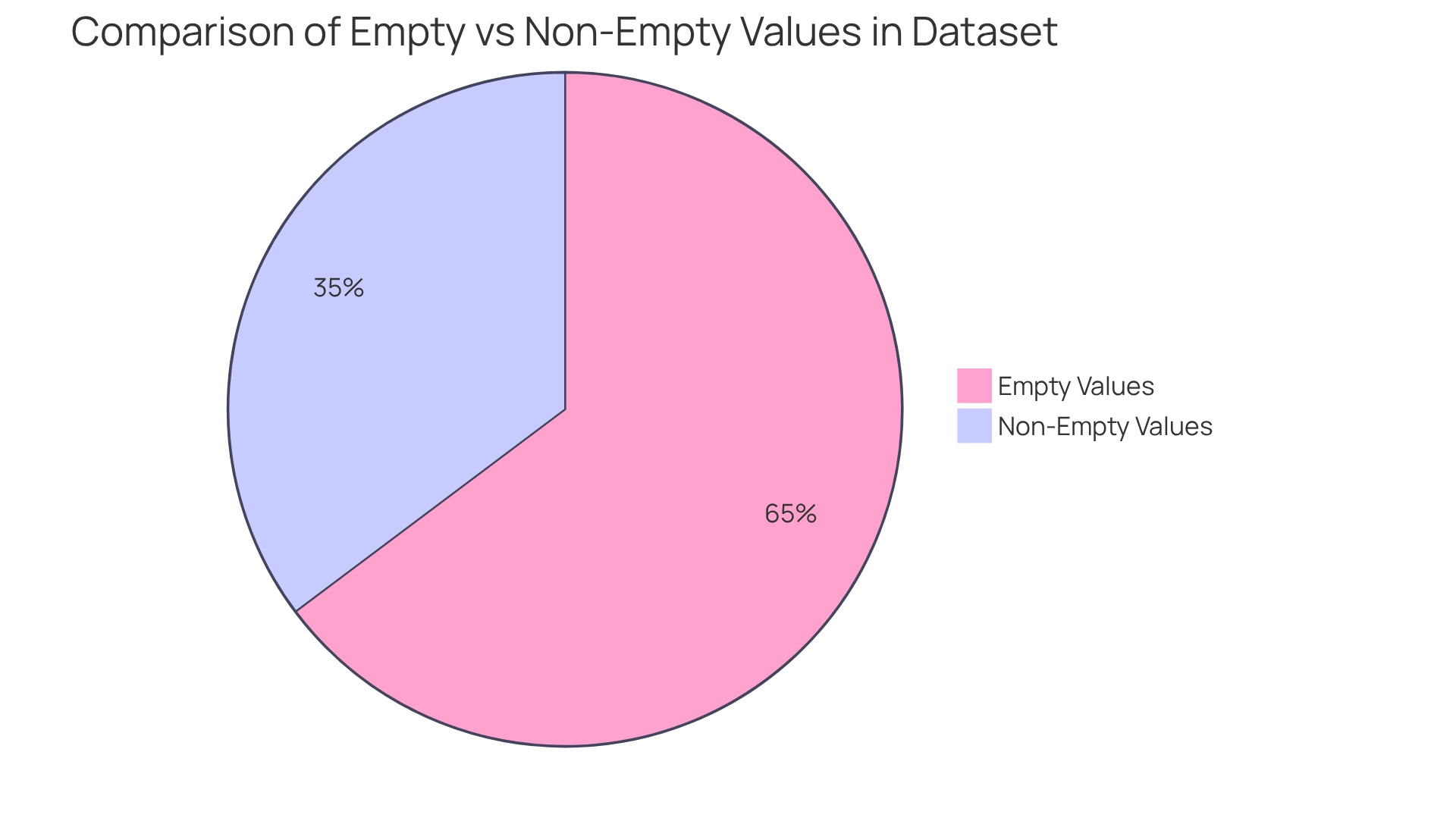
Advanced DAX Techniques for Transforming Null Values
For experienced users, a range of DAX methods can be employed to effectively modify empty entries, a critical aspect in leveraging Business Intelligence for operational efficiency. A powerful approach involves utilizing the SWITCH function alongside ISBLANK, which enables the creation of intricate conditional logic. For instance, the expression SWITCH(TRUE(), ISBLANK(value1), 'Value is missing', ISBLANK(value2), 'Another value is missing', 'All values present') offers comprehensive feedback on which specific values are absent, thereby enhancing the clarity of your analysis and addressing issues such as inconsistencies.
Moreover, the UNION function can be utilized to merge tables while adeptly managing missing values, allowing for more flexible information modeling. This is particularly advantageous in scenarios where information integrity is paramount, especially when aiming to extract significant insights from Power BI dashboards. Additionally, employing calculated columns to prepare data facilitates the replacement of empty entries with meaningful values before their integration into measures.
This practice ensures that analyses are grounded in reliable information, ultimately leading to more accurate insights that drive growth and innovation.
Integrating these advanced DAX techniques not only streamlines the management of absent entries but also aligns with best practices for data modeling. Case studies underscore the importance of meaningful naming conventions, clear relationships, and optimized types. The star schema, consisting of a central fact table linked to various dimension tables, provides a structured framework that enhances the management of empty values within data models. Understanding row context, which pertains to the current row in a calculated column, and filter context, which relates to filters in reports, is crucial for effectively addressing null values in DAX.
As Amitabh Saxena notes, “Power Query M is straightforward and efficient in addressing issues with the coalesce operator,” highlighting the value of employing simple yet powerful tools in data transformation. By adopting these strategies, professionals can significantly boost the performance and maintainability of their Power BI models, effectively overcoming the challenges of time-consuming report creation and ensuring actionable insights for informed decision-making.
To further enhance operational efficiency, consider exploring our RPA solutions, including EMMA RPA and Power Automate, which can automate repetitive tasks and improve overall productivity. Don’t let the competitive disadvantage of not utilizing Business Intelligence impede your business—schedule a free consultation today to discover how we can assist you in transforming your data into actionable insights.
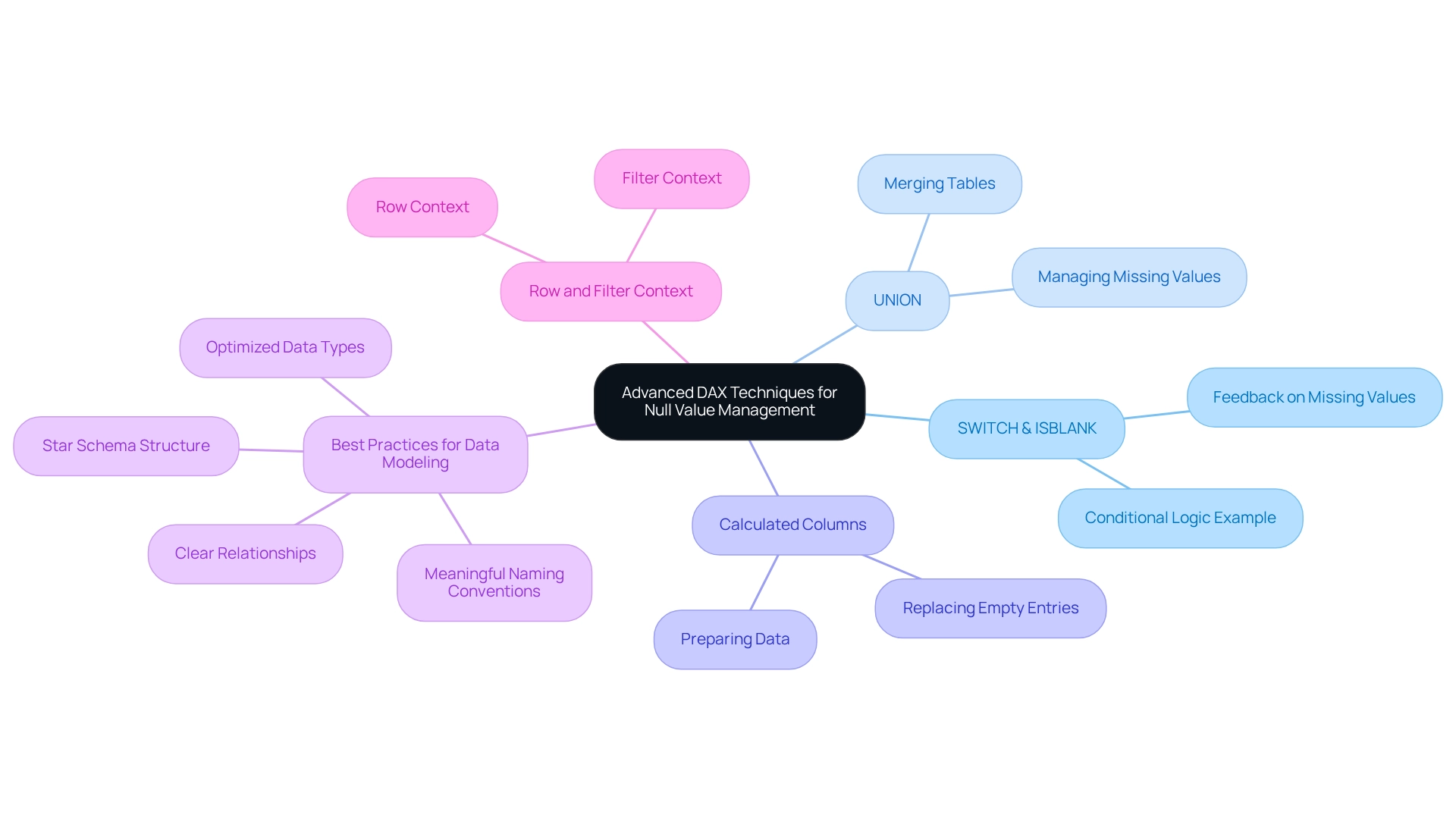
Impact of Null Values on Data Integrity and Analysis
Null entries, often referred to as null in DAX, pose a significant threat to data integrity and can severely distort analysis outcomes. If left unaddressed, these principles can lead to biased results, as calculations may overlook or misinterpret them. For instance, combining datasets that include gaps can distort averages and totals, leading to deceptive insights that mislead decision-making.
Moreover, empty entries complicate relationships among information, resulting in incomplete or flawed visual representations that fail to accurately depict the underlying data.
To maintain information integrity, it is essential to implement robust strategies for recognizing and handling missing entries throughout the information lifecycle. This involves conducting routine evaluations of information quality to proactively identify and manage omissions. Additionally, establishing strict information entry procedures can significantly decrease the occurrence of empty values, ensuring that the information remains trustworthy and usable.
Utilizing Business Intelligence tools enhances these processes by providing insights into information quality and facilitating better management practices.
Experts emphasize that mishandling absent values can undermine the trustworthiness of evaluations, underscoring the necessity for clarity in managing incomplete information. As Taran Kaur states, “Being open not only aids in establishing confidence in your results, but it also demonstrates that you’ve carefully reflected on how absent information might influence your evaluation.” By categorizing absent information into Missing Completely at Random (MCAR), Missing at Random (MAR), and Missing Not at Random (MNAR), specialists can gain clearer insights into the effects of null in DAX values and select appropriate techniques for examination and imputation.
This classification not only helps mitigate potential biases but also enhances the overall quality of insights derived from the data. Furthermore, conducting sensitivity evaluations to assess the robustness of results related to the MAR assumption is crucial, as suggested by the National Research Council. Care must also be taken with single imputation techniques such as EM, which can underestimate standard errors and overestimate precision, creating a misleading sense of power in evaluations. Recent studies focus on the handling of absent values in ordinal data, emphasizing ongoing research and its significance to current methods in information evaluation.
By incorporating these factors and employing RPA solutions like EMMA RPA and Power Automate from Creatum GmbH to streamline information management tasks, professionals can significantly enhance the integrity and reliability of their analyses, ultimately fostering business growth and innovation. Companies that fail to effectively extract valuable insights from their information risk falling behind their competitors in today’s data-driven environment.

Key Takeaways: Enhancing Data Quality with Null Management
To enhance information quality through efficient absence management, information specialists must first grasp the complexities of handling null values in DAX and the challenges they present. Essential DAX functions like ISBLANK, IF, and COALESCE serve as vital tools for effectively identifying and managing nulls in DAX. By applying best practices—such as proactive checks, equality checks, validation rules, profiling, and completeness checks—organizations can not only improve the accuracy of their analyses but also mitigate the risks associated with poor information, which IBM estimated cost the U.S. economy $3.1 trillion in 2016.
Furthermore, the integration of Business Intelligence (BI) and Robotic Process Automation (RPA) is pivotal in fostering data-driven insights and enhancing operational efficiency. Leveraging BI tools enables organizations to convert raw data into actionable insights that inform decision-making and promote growth. RPA solutions, including EMMA RPA and Power Automate, streamline repetitive tasks, thereby improving information quality and freeing up resources for more strategic initiatives.
Effective visualization methods are equally crucial in communicating the implications of absent entries to stakeholders, ensuring that the significance of information quality is acknowledged across the organization. As Chien remarked, “It is not only important to have the board’s attention in DQ improvement, but also for it to be a sustainable practice.” A case study focusing on trend monitoring illustrates how organizations can utilize time series evaluation to detect anomalies and oversee information quality over time, specifically addressing issues related to null values in DAX while distinguishing between normal fluctuations and genuine problems.
By embracing these strategies, data professionals can substantially enhance the integrity and reliability of their analyses, ultimately driving improved decision-making and operational efficiency.
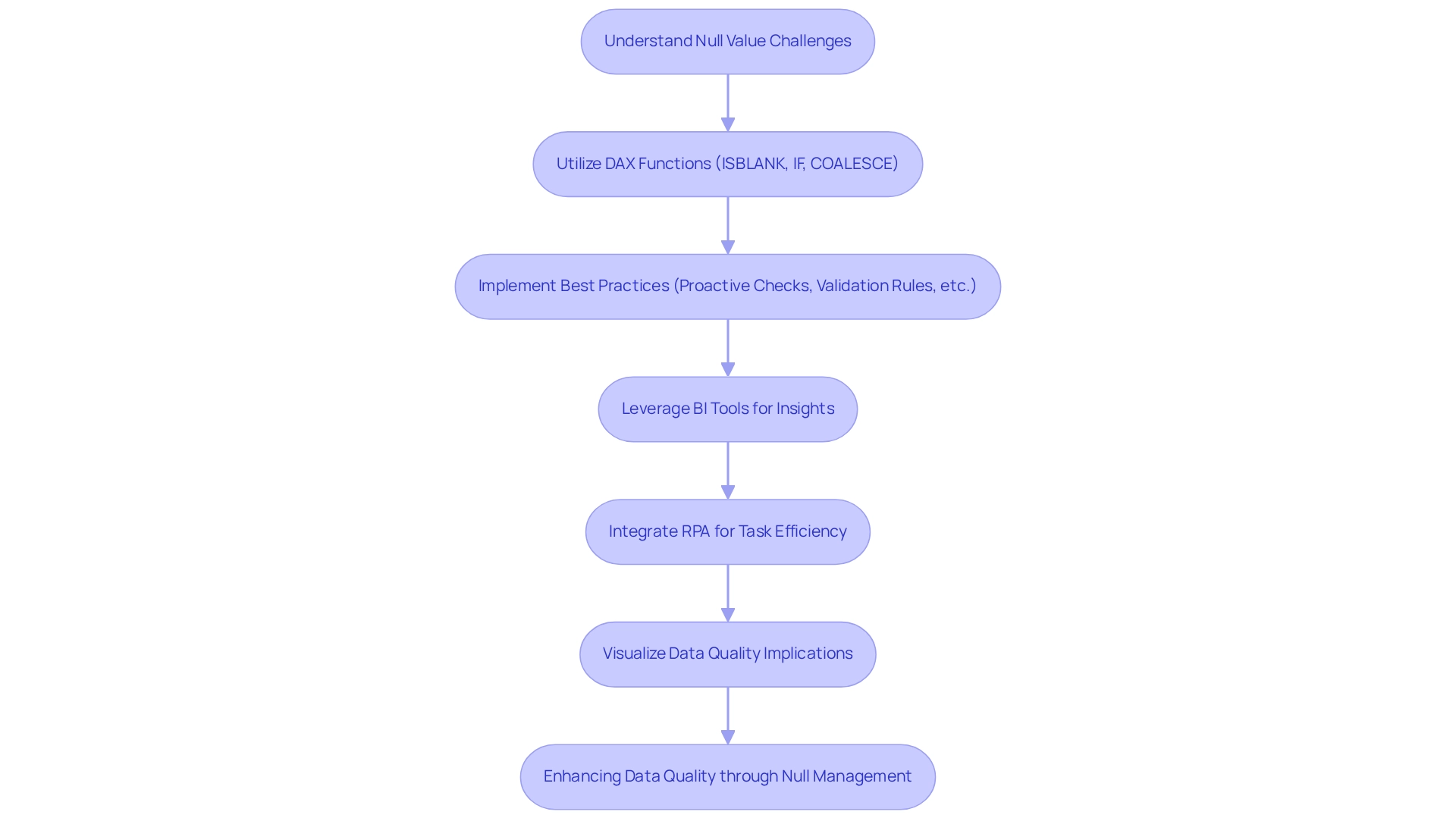
Conclusion
Managing null values in DAX is essential for ensuring data integrity and accuracy in analysis. This article highlights the critical distinctions between null values and other data types, emphasizing the unique handling required for ‘BLANK’ values to prevent misleading insights. By utilizing key DAX functions such as ISBLANK, IF, and COALESCE, data professionals can effectively identify and manage nulls, thereby enhancing the quality of their analyses.
Moreover, integrating best practices and advanced techniques, including conditional formatting in reporting and the SWITCH function for conditional logic, empowers analysts to visualize and address null values transparently. This proactive approach mitigates the risks associated with data quality issues and fosters trust in the insights derived from data.
Ultimately, effective null management is not merely a technical necessity; it is a strategic imperative that drives informed decision-making and operational efficiency. As organizations increasingly rely on data to guide their strategies, mastering the complexities of null values is crucial for data professionals aiming to deliver reliable and actionable insights. By prioritizing data quality and utilizing appropriate tools, businesses can position themselves for success in today’s competitive landscape, ensuring they harness the full potential of their data assets.
Frequently Asked Questions
What does ‘BLANK’ represent in DAX?
In DAX, ‘BLANK’ represents null entries, which are treated distinctly compared to other data types. Understanding how BLANK is interpreted is crucial for accurate data analysis.
Why is it important to understand the difference between an empty entry and zero in DAX?
An empty entry signifies the absence of information, while zero represents a numeric value. Misinterpreting these can lead to inaccuracies in calculations and aggregations.
How can poor handling of BLANK values affect data analysis?
Mismanagement of BLANK values can lead to unexpected outcomes in calculations, distorted results, misleading averages, and ultimately undermine the reliability of the analysis.
What are the challenges associated with managing null values in DAX?
Data experts often face difficulties with the misinterpretation of BLANK figures, complications in data relationships, and the overall precision of analyses, which can diminish data quality and reliability.
What role do Business Intelligence (BI) tools play in addressing information quality challenges?
BI tools help organizations tackle issues related to poor master information quality, enabling them to transform raw data into actionable insights that drive growth and innovation.
What methods can be employed to handle missing information effectively?
Identifying the type of absence and selecting appropriate handling methods, such as maximizing information collection during study design, can minimize information loss and bias.
Why is clarity in reporting how absent data was managed important?
Clarity in reporting is vital for building trust in findings and understanding the methodologies behind results, which enhances the credibility of the analysis.
How can organizations improve their handling of null values in DAX?
Establishing clear information governance policies and adhering to defined data management standards can improve the handling of null values, leading to more accurate and reliable analyses.
